Research News
-
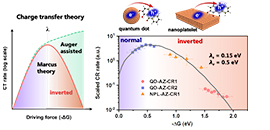 11 11, 2021Researchers Observe Marcus Inverted Region of Charge Transfer from Low-dimensional Semiconductor MaterialsScientists observed the Marcus inverted region of charge transfer from low-dimensional semiconductor materials.Charge transfer is a key step in photosynthesis, biological signal transduction, and conversion of various energy sources. The theoretical framework for charge transfer was established by Rudolph Marcus in the 1950s. It predicts the existence of a so-called "Marcus inverted region", where the transfer rate decreases with increasing reaction exothermicity (or driving force).Low-dimensional semiconductor materials are attracting enormous attention because of their strong potential for optoelectronic and energy-related applications. To date, however, it remains unclear whether Marcus theory is applicable to the charge transfer behavior of these materials.Recently, a research group led by Prof. WU Kaifeng from the Dalian Institute of Chemical Physics (DICP) of the Chinese Academy of Science (CAS) observed the Marcus inverted region of charge transfer from low-dimensional semiconductor materials.This study was published in Nature Communications on Nov. 3.Marcus inverted region is observed by measuring charge transfer from single-charge states of quantum dots and nanoplatelets (Image by WANG Junhui)The researchers built a unique model system using zero-dimensional quantum dots or two-dimensional nanoplatelets and surface-adsorbed molecules that allows for measuring charge transfer from transiently-populated, single-charge states.Combined with the capability of tuning the electron transfer driving forces through the quantum confinement effect, this measurement allowed to probe the fundamental energetics dependence of electron transfer, and to reveal a Marcus inverted region for these low-dimensional semiconductor materials."This is the first observation of a Marcus inverted region for low-dimensional semiconductor materials," said Prof. WU. "It may benefit energy conversion applications of these materials."The study was supported by the National Natural Science Foundation of China, the Strategic Pilot Science and Technology Project of CAS, the Ministry of Science and Technology of China and the Youth Innovation Promotion Association CAS. (Text by WANG Junhui)
11 11, 2021Researchers Observe Marcus Inverted Region of Charge Transfer from Low-dimensional Semiconductor MaterialsScientists observed the Marcus inverted region of charge transfer from low-dimensional semiconductor materials.Charge transfer is a key step in photosynthesis, biological signal transduction, and conversion of various energy sources. The theoretical framework for charge transfer was established by Rudolph Marcus in the 1950s. It predicts the existence of a so-called "Marcus inverted region", where the transfer rate decreases with increasing reaction exothermicity (or driving force).Low-dimensional semiconductor materials are attracting enormous attention because of their strong potential for optoelectronic and energy-related applications. To date, however, it remains unclear whether Marcus theory is applicable to the charge transfer behavior of these materials.Recently, a research group led by Prof. WU Kaifeng from the Dalian Institute of Chemical Physics (DICP) of the Chinese Academy of Science (CAS) observed the Marcus inverted region of charge transfer from low-dimensional semiconductor materials.This study was published in Nature Communications on Nov. 3.Marcus inverted region is observed by measuring charge transfer from single-charge states of quantum dots and nanoplatelets (Image by WANG Junhui)The researchers built a unique model system using zero-dimensional quantum dots or two-dimensional nanoplatelets and surface-adsorbed molecules that allows for measuring charge transfer from transiently-populated, single-charge states.Combined with the capability of tuning the electron transfer driving forces through the quantum confinement effect, this measurement allowed to probe the fundamental energetics dependence of electron transfer, and to reveal a Marcus inverted region for these low-dimensional semiconductor materials."This is the first observation of a Marcus inverted region for low-dimensional semiconductor materials," said Prof. WU. "It may benefit energy conversion applications of these materials."The study was supported by the National Natural Science Foundation of China, the Strategic Pilot Science and Technology Project of CAS, the Ministry of Science and Technology of China and the Youth Innovation Promotion Association CAS. (Text by WANG Junhui) -
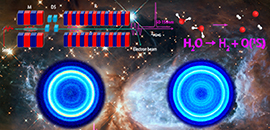 11 10, 2021Dalian Coherent Light Source Demonstrates Vibrationally Excited Molecular Hydrogen Production from Water Photochemistry
11 10, 2021Dalian Coherent Light Source Demonstrates Vibrationally Excited Molecular Hydrogen Production from Water Photochemistry
Vibrationally excited molecular hydrogen is an essential species for determining the chemical composition in the interstellar medium.
Vibrational excited interstellar H2 has been detected in shock-heated gas and in photodissociation regions (PDRs) near hot stars, which was formed by collisions and fluorescence excitation in PDRs.
Recently, a research group led by Prof. YUAN Kaijun and Prof. YANG Xueming from the Dalian Institute of Chemical Physics (DICP) of the Chinese Academy of Sciences (CAS) demonstrated vibrationally excited H2 production from the water photochemistry using the Dalian Coherent Light Source. This process represents a further source of vibrationally excited H2 observed in the interstellar medium.
Their findings were published in Nature Communications on Nov. 2.
Dalian Coherent Light Source revealing vibrationally excited molecular hydrogen production from the water photochemistry (Image by CHANG Yao)
The experimental results indicated that all of the H2 fragments identified in the O(1S) + H2(X1Σg+) channel following vacuum ultraviolet photodissociation of H2O in the wavelength range of λ=~100-112 nm were vibrationally excited. In particular, more than 90% of H2(X) fragments populated in a single vibrational state v=3 at λ~112.81 nm.
The estimated cross section for forming H2(v>0) fragments at λ~107.5 nm was determined to be ~3.2×10-18 cm2.
The abundance of the water molecules and vacuum ultraviolet photons in the interstellar space suggested that the contributions of these H2(v>0) sources from water photochemistry could be significant and thus should be recognized in appropriate interstellar chemistry models.
This research was supported by the Strategic Priority Research Program of CAS, Chemical Dynamics Research Center, and the National Natural Science Foundation of China. (Text by CHANG Yao) -
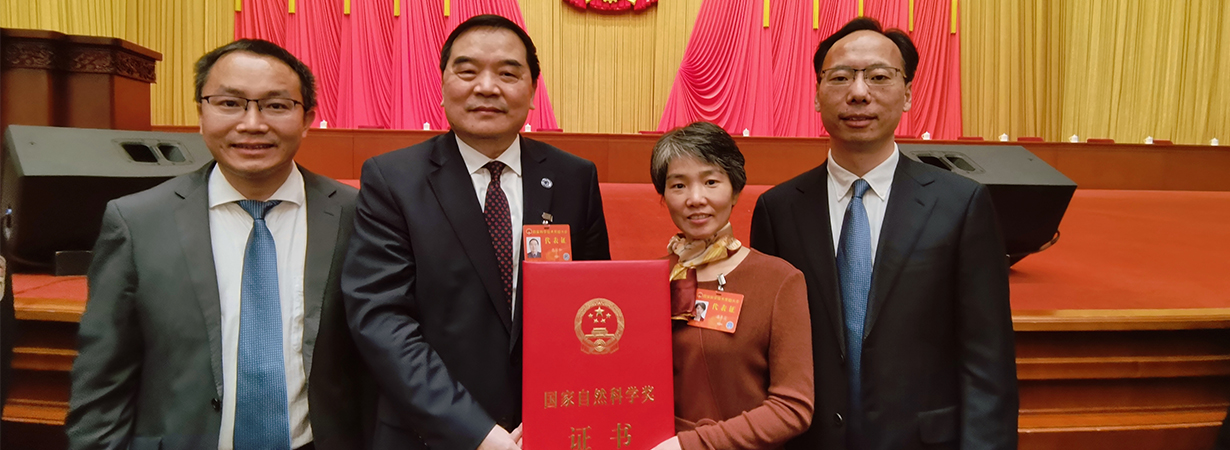 11 04, 2021"Nano-confined Catalysis" Wins the First Prize of 2020 State Natural Science AwardOriginal breakthroughs in chemistry and materials science have taken the first prizes of the 2020 State Natural Science Award, the nation's highest academic accolade for basic sciences.
11 04, 2021"Nano-confined Catalysis" Wins the First Prize of 2020 State Natural Science AwardOriginal breakthroughs in chemistry and materials science have taken the first prizes of the 2020 State Natural Science Award, the nation's highest academic accolade for basic sciences.
Original breakthroughs in chemistry and materials science have taken the first prizes of the 2020 State Natural Science Award, the nation's highest academic accolade for basic sciences.
One of the winning team is led by Prof. BAO from the Dalian Institute of Chemical Physics of the Chinese Academy of Sciences in Liaoning province.
As a key technology, catalysis has played an essential role in the fields of energy conversion, material synthesis, environmental protection, life and health. Precise control of chemical reaction has been a dream of scientists. This becomes particularly important under the current quests for highly efficient conversion of energies, optimized utilization of natural resources and ecological/environmental protection. It requires chemical reactions to be operated under milder conditions, to be more precisely and efficiently controlled. Therefore, the catalysis science and technology is confronted with grand challenges and opportunities for innovations.
Since the middle of the 1990s, Prof. BAO Xinhe from the Dalian Institute of Chemical Physics of the Chinese Academy of Sciences has been leading his research team and being devoted to the fundamentals and applications of nanocatalysis, pursing for deep understanding of catalytic processes and rational design of advanced catalysts. With the systematic experimental and theoretical studies over more than 20 years, they have developed a new concept of "Nano-confined Catalysis", which covers confinement effects within nanospaces and at interfaces.
The "Nano Confinement" is essentially the driving force to generate and stabilize the coordinatively unsaturated active sites and to maintain the catalytic cycles. This generalized concept provides a theoretical guidance for rational design of nanocatalysts, and modulation of activity and selectivity of reactions, for instance, selective oxidation and hydrogenation reactions.
The team has a few catalysts and catalytic processes gone through industrial pilot scale tests. One representative example is the Pt-FeO nanocatalyst they have designed, containing coordinatively unsaturated metal sites, which enables removal of 30 ppm CO in H2 feed gas down to 1 ppm in commercial fuel cells for over 3500 h. This provides a solution for the long-standing deactivation problem of Pt electrocatalysts in fuel cells due to poisoning of CO.
Another representative example is the OXZEO? catalytic system, by integrating interface and nanospace confinement effects. The coordinatively unsaturated active sites at the oxide/oxide interfaces of partially reduced mixed oxides allow activation of CO/H2 to form active intermediates, while the shape selective nanopores of zeolites allow controlled C-C coupling. Thus, coal-derived syngas (a mixture of CO and H2) is converted directly in one step to light olefins, i.e., ethylene, propylene and butane with a selectivity reaching 80%. This surpasses the selectivity limit of 58%, a challenge in the conventional Fischer-Tropsch synthesis, which was invented almost a century ago. Furthermore, water-gas-shift reaction for hydrogen production can be discarded in this OXZEO?-TO process and thus H2O-H2 recycling is not needed. In addition, the team has extended this OXZEO? catalyst design concept for direct conversion of syngas to a series of other chemicals and fuels, making significant contribution to the coal chemical industry. -
 11 02, 2021Scientists Capture Electron Transfer Image in Electrocatalysis ProcessScientists established the operando AFM/SKPM/SECM instrumental methodology with nanometer-scale spatial resolution, and revealed the quantitative correlation between the inner potential and the kinetic rate by separating the interference of mass transfer from the interfacial electron transfer
11 02, 2021Scientists Capture Electron Transfer Image in Electrocatalysis ProcessScientists established the operando AFM/SKPM/SECM instrumental methodology with nanometer-scale spatial resolution, and revealed the quantitative correlation between the inner potential and the kinetic rate by separating the interference of mass transfer from the interfacial electron transfer
The involvement between electron transfer (ET) and catalytic reaction at electrocatalyst surface makes electrochemical process challenging to understand and control. How to experimentally determine ET process occurred at nanoscale is important to understand the overall electrochemical reaction process at active sites.
Recently, a research group led by Prof. LI Can and Prof. FAN Fengtao from the Dalian Institute of Chemical Physics (DICP) of the Chinese Academy of Sciences (CAS) captured the ET image in electrocatalysis process.
This study was published in Nano Letters on Oct. 14.
Electron transfer current followed the trend: corner> edge> basal plane, driven by the interfacial inner potential differences (Imaged by NIE Wei and FAN Fengtao)
The researchers clearly captured the image of ET dominated by mass transport effect at corner and edge sites bounded by {111} facets on single Au triangular nanoplates. They found that ET rate constant of corner sites on Au nanoplate was about twofold that of basal {111} plane.
Furthermore, they found the linear correlation between the logarithm of rate constants and the potential differences of different sites, which demonstrated that spatial heterogeneity of local inner potential differences of Au nanoplates/solution interfaces plays a key role in the ET process.
"We establish the operando AFM/SKPM/SECM instrumental methodology with nanometer-scale spatial resolution, and reveal the quantitative correlation between the inner potential and the kinetic rate by separating the interference of mass transfer from the interfacial electron transfer," said Prof. LI.
"This is a new milestone of the scanning electrochemical probe techniques, making it possible to discover the structure-performance relation of nanocatalyst from the bottom of physical and chemical principles," commented by one of the reviewers.
This work was conducted by the Fundamental Research Center of Artificial Photosynthesis. And it was supported by National Natural Science Foundation of China, CAS Projects for Young Scientists in Basic research, and Interdisciplinary Innovation Team. (Text by NIE Wei and FAN Fengtao) -
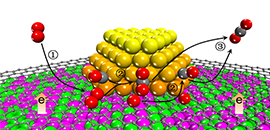 11 01, 2021"Chainmail Catalysis" Improves Efficiency of CO Oxidation at Room TemperatureScientists from DICP designed a chainmail catalysis of graphene-isolated Pt from CoNi nanoparticles (Pt|CoNi) for CO oxidation at room temperature.
11 01, 2021"Chainmail Catalysis" Improves Efficiency of CO Oxidation at Room TemperatureScientists from DICP designed a chainmail catalysis of graphene-isolated Pt from CoNi nanoparticles (Pt|CoNi) for CO oxidation at room temperature.
CO oxidation at room temperature is significant for gas purification. Pt promoted by 3d transition metals (TMs) is a promising candidate for this reaction. However, TMs are prone to be deeply oxidized in an oxygen-rich atmosphere, leading to low activity.
Recently, a research group led by Prof. DENG Dehui from the Dalian Institute of Chemical Physics (DICP) of the Chinese Academy of Sciences (CAS) designed a chainmail catalysis of graphene-isolated Pt from CoNi nanoparticles (Pt|CoNi) for CO oxidation at room temperature.
The study was published in Nature Communication on October 04.
Graphene-isolated Pt from CoNi nanoparticles (Pt|CoNi) for efficiently catalytic CO oxidation (Image by HU Jingting)
CoNi alloy was protected by ultrathin graphene shell from oxidation and therefore modulated the electronic property of Pt-graphene interface via electron penetration effect. It achieved near 100% CO conversion at room temperature, while there were limited conversions over Pt/C and Pt/CoNiOx catalysts.
By experiments and theoretical calculations, the researchers indicated that CO could saturate Pt sites, but O2 could adsorb at the Pt-graphene interface without competing with CO, which facilitated the O2 activation and the subsequent surface reaction.
"The graphene-isolated system in this work is distinct from the classical metal-metal oxide interface for catalysis, and it provides a new thought for the design of heterogeneous catalysts," said Prof. DENG.
This work was supported by the National Key R&D Program of China, the National Natural Science Foundation of China, the Strategic Priority Research Program of CAS, and Collaborative Innovation Center of Chemistry for Energy Materials (2011. iChEM). (Text by HU Jingting) -
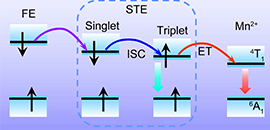 10 18, 2021Scientists Synthesize Double Perovskite Nanocrystals with Bright Emission Based on Triplet Self-Trapped ExcitonsScientists from DICP synthesized double perovskite NCs with bright PL emission based on triplet STEs.
10 18, 2021Scientists Synthesize Double Perovskite Nanocrystals with Bright Emission Based on Triplet Self-Trapped ExcitonsScientists from DICP synthesized double perovskite NCs with bright PL emission based on triplet STEs.
Different from the narrow band emission based on free excitons in lead-perovskite nanocrystals (NCs), the low electronic dimensionality in lead-free double perovskite NCs can lead to self-trapped excitons (STEs), giving a broadband emission.
To date, how the singlet/triplet STEs influence the photoluminescence (PL) properties and whether triplet STEs can give efficient emission in double-perovskite NCs are still unclear.
Recently, a research team led by Prof. HAN Keli and YANG Bin from the Dalian Institute of Chemical Physics (DICP) of the Chinese Academy of Sciences synthesized double perovskite NCs with bright PL emission based on triplet STEs.
This study was published in Nano Letters on Oct. 11.
Efficient emission based on the triplet STEs and the energy transition process (Image by CONG Muyu and YANG Bin)
They synthesized lead-free double perovskite NCs with varying sizes. The optical results indicated that the size had negligible influence on the absorption and PL peak position, while which mainly affected the PL quantum yield (PLQY). They further modified the Sb doping content, and obtained the NCs with bright green emission, whose PLQY was as high as 95%.
They also studied the dynamics of triplet STEs in double perovskite NCs via the measurements such as time-resolution PL (TR-PL), femtosecond transient absorption (TA), and magneto-optical spectroscopic measurement.
Furthermore, they achieved the triplet STEs mediated efficient energy transfer to dopants by alloying with Mn2+, and they formed the efficient white-emission with high PLQY of 87%. In addition, they formulated simple LEDs based the Mn2+ alloy NCs.
"This work may boost the understanding of STEs in double perovskites and promote its development in illumination-related applications," said Prof. HAN.
This work was supported by the National Natural Science Foundation of China, the National Key Research and Development Program of China, and the Science Challenging Program. (Text by CONG Muyu and YANG Bin)